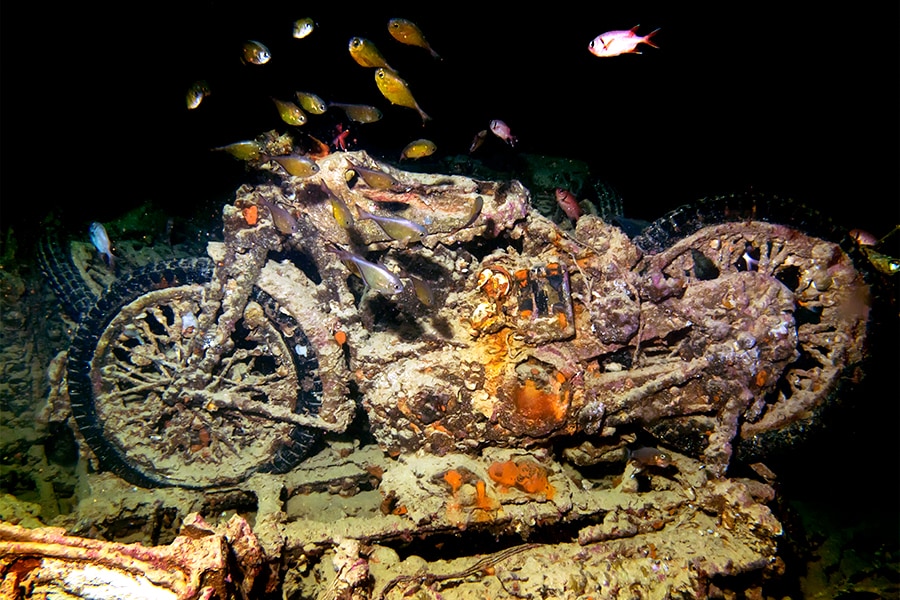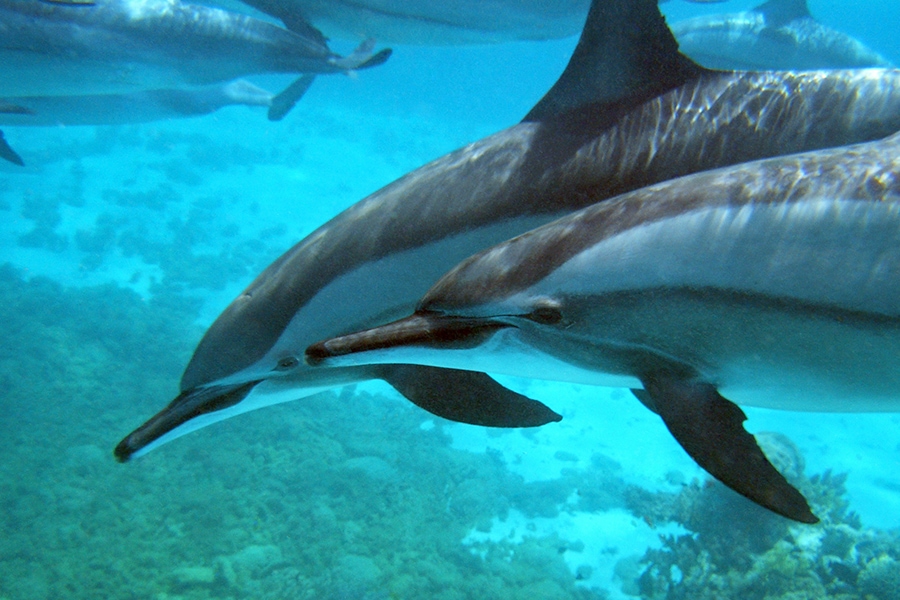
Why Visit North and Tiran on a Red Sea Dive Trip?
Divers who visit the Red Sea are usually searching for one of two things: sharks or wrecks. In the northern Red Sea, it’s almost difficult to find a dive site without a wreck! Further south, pinnacle reefs with frequent shark sightings are the highlight.
However, North and Tiran trips are very unique. The variety of dive sites makes it ideal for any diver! The area offers a fantastic mixture of penetrable wrecks and vibrant reefs. Sharks aren’t a frequent visitor, but all the sites are absolutely teeming with life – including playful dolphins at certain spots.

Diving All Star Scuba Scene’s North and Tiran itinerary provides an opportunity to explore the famous Thistlegorm wreck, the overwhelmingly colorful reefs in Ras Mohamed National Park, several of the wrecks around Abu Nuhas, and the Strait of Tiran’s remote pinnacles. No matter whether you prefer reefs or wrecks, this area of the Red Sea has plenty to offer.
Wreck of the SS Thistlegorm

The holy grail of wrecks is situated comfortably at the opening of the Gulf of Suez. With a length of over 400 feet, there is plenty to explore. The whole wreck is within recreational diving limits, so anyone with an Advanced certification can explore the whole thing! Scuba Scene often dives the Thistlegorm two or three times during Northern and Tiran trips – and, trust me, even three dives on this site aren’t enough.
Currents can be strong on the site sometimes, but your liveaboard crew will make sure it is safe and find out the current’s strength and direction before delivering the briefing.
Even penetrating the SS Thistlegorm is surprisingly easy. Numerous points of entry and exit keep it stress-free and well-lit. Glassfish, among many others, reside in the wreck and make for very interesting photo subjects. Outside the wreck, anything from nudibranchs to crocodilefish to the site’s resident sea turtle can be spotted.
And, as if the incredible marine life wasn’t enough, the SS Thistlegorm is basically a sunken museum. World War II artifacts are scattered throughout the cargo holds. Divers can see rifles, bombs, motorcycles, jeeps, and even soldiers’ boots – all covered in coral now.
To get the most out of this dive, it’s best to follow the directions given in the dive briefing. The currents can be tricky on the outside, but your dive guide will have a great plan for keeping the swim relaxed.

The Thistlegorm doesn’t look like it used to – don’t wait until it’s too late to dive it! Eighty years under water have taken their toll, and it certainly won’t be around forever.
Ras Mohammed National Park

When people think of diving in the Red Sea, they imagine the bright soft corals and thousands of tiny anthias swarming the reef…Ras Mohamed delivers exactly that. Diving Shark and Yolanda Reef is like giant-striding into a Van Gogh painting. It’s almost overwhelming to see so many colors and fish.
Every inch of the wall is covered with pristine hard and soft corals. Countless anthias hover by the reef as far as you can see, and you might even spot something bigger swimming by if you keep an eye on the blue. At the wreckage of the Yolanda, there is a sandy bottom where a large blue-spotted stingray population likes to hunt.
The wreckage of the Yolanda also offers another unique feature…its cargo of toilet seats. It’s a bit strange, but it actually hosts a variety of interesting marine life – and who doesn’t want a picture with an underwater toilet seat mountain?
Strait of Tiran

Beautiful corals and absolutely mesmerizing fish life define Tiran dive sites. Between the coasts of Saudi Arabia and the Sinai Peninsula, four pinnacle reefs reach almost to the surface – Jackson Reef, Thomas Reef, Woodhouse Reef, and Gordon Reef, which actually has an above-water shipwreck resting on it! On Scuba Scene, these reefs are only visited on North and Tiran trips.
Exploring the walls gives divers another chance to enjoy the classic Red Sea view of vibrant soft corals through a beautifully disorienting sheet of bright orange anthias. Triggerfish and batfish zigzag around the water above, and huge schools of jacks dart by in the blue.
Currents can be strong along the walls, but this makes for fantastic drift dive opportunities. The currents also serve the lovely purpose of attracting large pelagic creatures to the area. When I dived Jackson Reef, a manta ray was spotted as we were getting out of the water – this isn’t a particularly common encounter, but it certainly lends to the fact that this nutrient-rich area brings in amazing pelagics!
All the reefs are great, but Thomas Reef is an especially exciting site for tech divers. The notorious Thomas Canyon begins at a little further than 100 feet, so a Deep Diver specialty is needed to actually reach the opening. Tech divers are even able to descend into the canyon to admire the eerie and unique topography.
Abu Nuhas

For those in favor of a good wreck dive, Abu Nuhas is the place to be. It’s home to four incredible wrecks. Each is known by its cargo: Carnatic (wine wreck), Kimon M (lentil wreck), Chrisoula K (tile wreck), Giannis D (wood wreck). The wreck of the Carnatic, which sank in 1869, is the oldest of the bunch; Giannis D is the youngest, having sunk in 1983. Each of these wrecks offers stellar diving within recreational depth limits.
Marine life on the wrecks ranges from beautiful macro creatures to passing dolphins – and everything in between. Plus, the cargo and the structures themselves are dramatic and hauntingly beautiful. Night dives at these sites offer the chance to see some exciting nocturnal creatures around the spooky scenery of the wreckages.
The northern Red Sea hosts a nice selection of wrecks that can be explored by divers who have limited wreck diving experience.
Dolphinhouse Reef

Opportunities to dive with wild dolphins are few and far between, so a dive site that boasts consistent encounters is certainly noteworthy. Playful pods of bottlenose dolphins visit the area predictably and frequently, so divers have a pretty good chance of getting to see some while exploring the reef – lucky divers even get to interact with these graceful marine mammals on occasion!
They will sometimes pick up a piece of coral and drop it near a diver in hopes that the diver will play a game almost like underwater fetch! The diver will drop the coral, the dolphin will pick it up and bring it back, and the cycle repeats until the dolphin is bored. Nature is incredible, and dolphins are one-of-a-kind.
In addition to the possibility of dolphins, the dive site itself is stellar. Brightly colored soft corals surround a sandy bottom that’s dotted with small coral heads. On each of the little coral heads along the bottom, tiny fish and porcelain crabs can be found hiding in the branches. The fish at Dolphinhouse are surprisingly friendly, as well. When I dived the site, each of us in the group had our own parrotfish or wrasse that lingered within arm’s reach, nonchalantly waiting for us to inadvertently create the opportunity for them to find a meal.
Gubal Island

The Barge at Bluff Point is one of the most beloved dives sites in the northern Red Sea. Though there isn’t much left of the wreck, but it hosts an unbelievable variety of life. From strange macro creatures to a famously enormous giant moray named George, this site demands your full attention.The first time you see a big moray on this site, you’ll think you’ve found George…then you REALLY find him. He’s nothing short of a sea monster!
This area is so full of life, more and more eels are beginning to look like George. This growing number of large predators is an amazing indicator of a thriving food chain – and we’re lucky to be able to visit and see the benefits ourselves.
The wreck of the SS Ulysses also rests at the bottom of Small Gubal Island. This wreck is in rough shape. Nearly all that is left is the vessel’s bracing, so it looks something like the skeleton of a boat as you approach.
Fortunately, the ship’s current state actually makes for an easier penetration dive. Light flows directly into the hull, and there are many points through which divers can exit. Bottom time and exceeding depth limits are also not a major concern for this site, as the maximum depth is less than 100 feet. It’s an ideal site for less experienced divers who want to try out wreck diving.
Visit Aboard All Star Scuba Scene!
Every diver should have the opportunity to visit the Red Sea’s North and Tiran area. Of course, a liveaboard is necessary to hit all the best sites at the right times. On Scuba Scene, it’s easy and fun – plus, you may even get to do your dives with Dr. Elke Bojanowski, founder of the Red Sea Sharks Trust.
With diving of this quality, your accommodations should match! And, fortunately, the low prices make it possible to enjoy these amazing dives from the comfort of a luxurious vessel – All Star Scuba Scene.



